Draining Lake Nicaragua and flowing into the Caribbean is a large river, the Río San Juan de Nicaragua. A great deal of history has passed along this river over the centuries. Before modern highways and air travel this was the main transportation route into the rich lands of central Nicaragua, bypassing the thick belt of rain forest and jungle on the Caribbean coast.
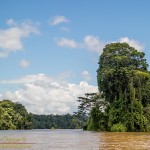
The Río San Juan has seen the passage of Spanish Conquistadors, pirates and foreign armies bent on conquering what is now Nicaragua. Along this route thousands of forty-niners came on their way to the California gold fields, using the river to cross the isthmus to the Pacific Ocean. The border of Nicaragua and Costa Rica is also defined by the south bank along much of the river’s length. While the river’s importance on the international stage has waned, it is still a critical route for local residents that call the region home. Dozens of vessels, from river taxis to barges carry people and cargo to the towns and farms that depend on the river.
The river is also popular with the more adventurous tourists. The history and natural beauty found here makes the area endlessly fascinating. Several large biologic preserves along the river preserve large tracts of natural jungle. Fishermen from across the world come to the Río San Juan as well. Here you can catch Tarpon, a renowned sport fish that can reach 2 meters in length and weigh 100kg.
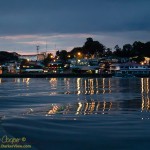
Our journey started at the usual place, the city of San Carlos. Situated on a point of land between Lake Nicaragua and the river, the city sits at the source of the Río San Juan. The city is served by air service from Managua and can be reached by traveling excellent highways from the north. We had driven from Camoapa after finishing up with our business there, an enjoyable three hour drive across the Nicaraguan countryside.

Our first night would be spent at La Esquina Del Lago, a fishing lodge located directly across the river mouth from San Carlos. Our arrival in San Carlos is right at sunset, our introduction to the river is a beautiful twilight scene with the lights of San Carlos behind as we shuttle across to the lodge.
My father has been coming here for years and knows the lodge owner. We took advantage of the slow season to hire one of the lodge fishing boats for a few days. With our own boat we would be able to tour where and when we wanted. We could go slow and travel on our own schedule, not something that we could do with when traveling on the river taxis. At times we went fast, other times we poked along as close to the riverbank and jungle as we could, spotting the birds and wildlife of the river. And we did a little fishing along the way.
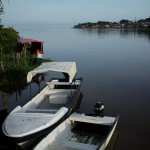
The lodge is run by Philippe, an ex-pat Frenchman who built the lodge from nothing. It may be overly stereotypical, but the food was excellent, the best of our trip, as one would expect in a French run lodge. Philippe caters to fishermen from all over the world, offering a perfect location for either fishing or exploring the length of the river. The experience is rustic, do not expect air conditioning and internet here, just a beautiful view of sunset over Lake Nicaragua.
A good portion of our bill is paid with the contents of a dufflebag I had been hauling all of the way from Portland. Thousands of meters of fishing line, an outboard propeller, and fishing tackle. Philippe had sent my father a shopping list, equipment that is difficult to locate in this remote area.
The boat was a classic panga, with a high bow and narrow beam that is perfectly suited for traveling the river. The boat was comfortable and quite seaworthy, with a small canopy amidships to allow us to escape the intense tropical sunlight. The motor did not like being run slowly, running rough, but pushed us along at a good clip when the throttle was open. Every day of the trip the rumble of the outboard motor was a constant companion.
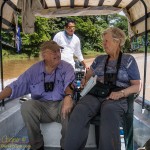
Steering us along the river was our steady driver, Champagne, staying at the tiller rain or shine. And it did rain, tropical downpours soaking him as we sheltered under the canopy. He knew the river well, steering us safely on an unpredictable wild river. Cautious when he needed to be, he would not let us ride through the rapids at El Castillo, we walked around on the portage road through town.
As noted we did a little fishing. On our first full day on the river we paused to troll near the new highway bridge. We trolled for about an hour without catching anything. Noting the signs of impatience from my mother, dad announced we would make one more pass. Just as we passed the bridge pier the line jumped hard… Fish On!
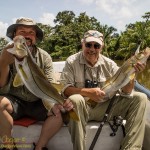
The fight did not last all that long, a couple minutes. With a strong jump out of the water the tarpon shook the hook. No surprise, tarpon is a catch and release fishery here, the hook was barbless. The jump let us get a good look at the fish, a respectable representation of the species, between 4 and 5 feet long, and likely over a hundred pounds. Not the largest tarpon my father had caught here, but enough to satisfy him for the trip.
A few miles downstream we paused again to fish, a different target this time. At a bend in the river known for snook we waited less than five minutes to get a strike. Actually we got two hits within seconds, both poles had a fish. It took only a short time before we had both fish onboard. We may have to release tarpon, we will eat the snook.
We paused at the Hotel Sábalos for lunch. Handing a fish to the staff we would have it for lunch. They did not blink, simply asking us how we would like it prepared. It is clear that a good deal of their business is from sport fishers. A trio of platters of pan fried snook appeared a short while later. We only ate about a third of the good sized fish, all we needed, the remainder donated to the kitchen for other meals as part of the arrangement.
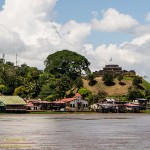
The next two nights would be spent in El Castillo. The town is a pleasant place to stay, founded around the old Spanish fortification that gives the town its name. Completed in 1675 this fortress controls the river, access the old colonial city of Grenada and the entire center of the country. A substantial fortification, the fort is well worth the visit. On a high bluff above the river the view itself is a good reason to walk up the hill.
Castillo also serves as a market town for this section of the river and provides convenient access to the biological preserves just a few miles downriver. Thus you will see quite a few foreign tourists here. In our visit I noted far more European countries represented than other nationalities traveling the river.

As a notable tourist town Castillo has quite an array of hotels to choose from. We stayed at the Hotel Victoria, arguably the best hotel in town. Located at the downriver end of the street this hotel features air conditioning and internet access, at least on the one provided desktop computer, no WiFi. A very nice building kept spotless by the staff, polished tropical hardwoods panel the walls and floors. As usual along the river there was no hot water. The food was quite good, a full menu available, a ceviche they made out of our second fish was very good.
With two nights spent here, the intervening day would be used to travel downriver the the reserve at Bartola. Each evening I had a chance to visit the fortress and walk the streets with a camera. Tourists are normal here, my camera attracting little attention, except from the kids who often pose for a photo.
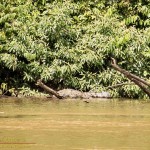
Indio Maíz Biological Reserve is quite large, protecting more than 318,000 hectares (1220 square miles) of tropical dry forest. We saw a tiny fraction of that, only mile or two on the trails near the mouth of the Río Bartola. But even that small area revealed many things we had never seen before.
Our guide found several of the small colorful tropical tree frogs for us to marvel at including the green and black poison dart frog (Dendrobates auratus). There were howler monkeys (Alouatta palliata) in the trees overhead, an agouti (Dasyprocta punctata) crossed the trail in front of us, the loud buzz of cicadas, locally called Chicharra, pulsated through the treetops.
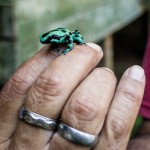
The plants were equally amazing. A dwarf palm with innumerable needle spines along the trunk. Towering tropical hardwoods that dominate the forest. A small herbaceous shrub that numbed the mouth when a tiny bit was chewed, quite similar in effect as Novocaine.
It was some of the smaller things that caught my attention. Sever times the trail intersected with the miniature roads constructed by leafcutter ants. Thousands of ants marched along each returning with a neatly cut piece of leaf to add to the fungus gardens in the nest. Across a stump lines of termites marched in amazingly neat parallel lines. This is an amazingly intact rain forest, alive with life everywhere you look.
After Castillo is was back upriver to Sábalos, we would spend another night here. The trip from Castillo to Sábalos is fairly short, we arrived well before noon. After checking in and dropping luggage in the rooms we had plenty of time for another excursion. My mother wanted to see a cocoa farm up the river Sábalos so off we went.
The farm was interesting. In addition to the cocoa trees there were quite a few other tropical fruits. The larger fruit trees used to shelter the cocoa which is an under-story tree that requires some shade. Living in Hawaii I recognized almost all of the fruits here, breadfruit, mango, and soursop are easy, but not all, there were a couple I did not know.
Partway through the tour a tropical downpour caught us. We spent a while sheltering under the tin roof of a compost shed watching the rain. No matter, the master gardener side of my mother checked out the compost system. Note… They were doing it right.
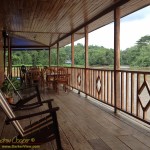
The hotel is on the opposite side of the Sábalos river from the center of town, located on the point where this tributary enters the Rio San Juan. Much of the settlement and the main road are also on this side of the river, thus a vehicle ferry is located just upriver. For foot traffic there are several small ferries that shuttle back and forth across. Two cordoba (about ten cents) will get you a ride to the other side.
Hotel Sábalos is a single row of rooms along a long porch overhanging the river with a spectacular view. At the dock end a large open area serves as a lounge and dining area, all under cover to keep the usual evening showers from spoiling your dinner. After the last plates were cleared I set up a camera to photograph a beautiful line of thunderstorms to the south over Costa Rica.
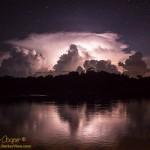
There is no hot water, though the cold is merely tepid, providing a rather refreshing shower. No air conditioning either, air temperature is moderated by the pleasant breeze, a result of the location overhanging the river. The real surprise was WiFi, provided by a single WAP on the porch, just look on the bottom of the unit for the password. Another round of SMS messages back and forth with my wife at home!
The food was quite decent as well, a full menu of standard dishes. This was the same kitchen that had prepared our snook earlier in the trip.
From Sábalos it was a short run back to San Carlos and a flight to Managua. We had plenty of time, starting right out after an early breakfast. We took our time on the trip upriver, enjoying our last hours on the water. We slowly motored up some of the side channels, binoculars and bird books handy. We spotted a couple new species of heron, a Montezuma oropendola, and spider monkeys in the trees overhanging the river. Another surprise was a vulture feeding on a dead caiman floating in the middle of the river.
Travelling the Rio San Juan is not a voyage for many travelers. The conditions you will face are decidedly rugged, with odd bits of simple luxury here and there. If you can do without hot water, do not mind the occasional cockroach, and can sleep in a stifling tropical rain forest without air conditioning, no problem. There are rewards for the adventure traveler here.

